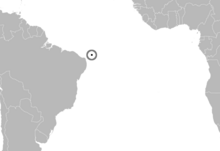| Noronhomys | |
|---|---|
| Scientific classification | |
| Domain: | Eukaryota |
| Kingdom: | Animalia |
| Phylum: | Chordata |
| Class: | Mammalia |
| Order: | Rodentia |
| Family: | Cricetidae |
| Subfamily: | Sigmodontinae |
| Genus: | †Noronhomys Carplaton and Olson, 1999 |
| Species: | †N. vespuccii
|
| Binomial name | |
| †Noronhomys vespuccii Carleton and Olson, 1999
| |

| |
| Location of Fernando de Noronha, the island group to which Noronhomys was endemic. | |
Noronhomys vespuccii, also known as Vespucci's rodent,[2] is an extinct rat species from the islands of Fernando de Noronha off northeastern Brazil. Italian explorer Amerigo Vespucci may have seen it on a visit to Fernando de Noronha in 1503, but it subsequently became extinct, perhaps because of the exotic rats and mice introduced by the first explorers of the island. Numerous but fragmentary fossil remains of the animal, of uncertain but probably Holocene age, were discovered in 1973 and described in 1999.
Noronhomys vespuccii was a fairly large rodent, larger than the black rat (Rattus rattus). A member of the family Cricetidae and subfamily Sigmodontinae, it shares several distinctive characters with Holochilus and related genera within the tribe Oryzomyini, including high-crowned molars with simplified crown features and the presence of several ridges on the skull which help anchor the chewing muscles. Although a suite of traits suggest that Holochilus is its closest relative, it is distinctive in many ways and is therefore classified in a separate genus, Noronhomys. Its close relatives, including Holochilus and Lundomys, are adapted to a semiaquatic lifestyle, spending much of their time in the water, but features of the Noronhomys bones suggest that it lost its semiaquatic lifestyle, after arrival at its remote island.
- ^ Weksler, M. & Costa , L.M. 2019. Noronhomys vespuccii. The IUCN Red List of Threatened Species 2019: e.T136692A22333193. https://dx.doi.org/10.2305/IUCN.UK.2019-1.RLTS.T136692A22333193.en. Accessed on 01 May 2023.
- ^ Musser and Carleton, 2005, p. 1136
